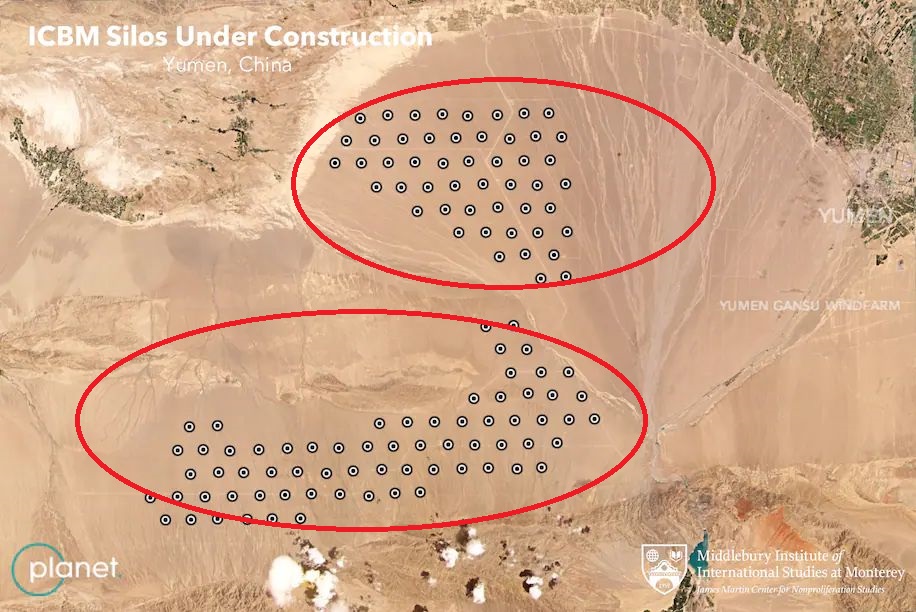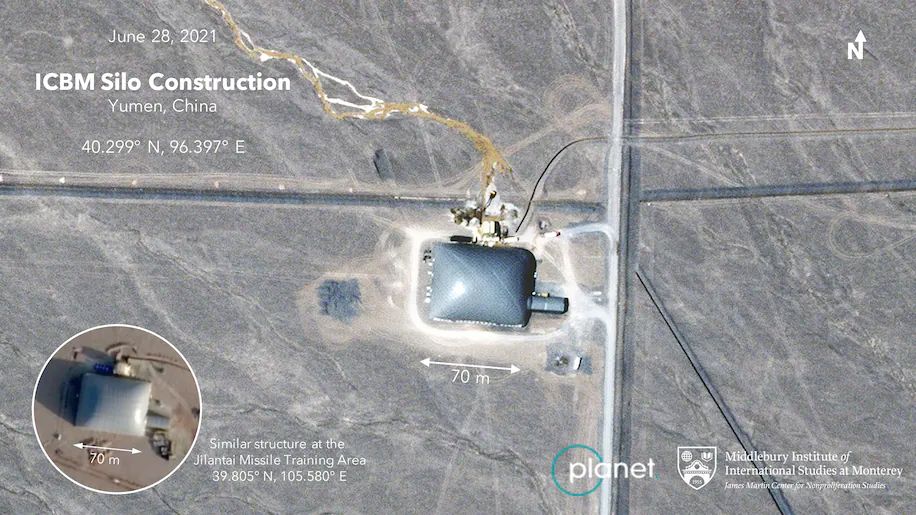
According to a report released by the U.S. Defense Department last September, China is dramatically expanding its arsenal of nuclear-armed intercontinental ballistic missiles (ICBMs) that can strike the United States. China had about 100 of those missiles but was expected to double that number in the coming years, the report said.
However, a Washington Post report on Wednesday shows that China is building more than what was anticipated in the report. The Washington Post report showed large number of structures in the desert of China’s Gansu province, outside a small city called Yumen, that were identical to the ones housing missile silos at Jilantai mentioned in the US report. But while Jilantai has only 16 of each structure, the site near Yumen has nearly 145. Experts suspect that these silos are probably for China’s newest nuclear-armed missile, the DF-41.
It was believed that China has a force of only about 100 ICBMs and a stockpile of 250 to 350 nuclear weapons. But the new finding of another 145 or so silos that can host ICBMs has the world concerned.
Jeffrey Lewis, Director of the East Asia Nonproliferation Program at the Center for Nonproliferation Studies and a part of the Middlebury Institute of International Studies was part of a team that analyzed the suspicious sites. He and his colleague Decker Eveleth first spotted the silos in the photos taken by commercial satellites over northwestern China.
“If the silos under construction at other sites across China are added to the count, the total comes to about 145 silos under construction,” Lewis said in a summary of his findings provided to The Washington Post. “We believe China is expanding its nuclear forces in part to maintain a deterrent that can survive a U.S. first strike in sufficient numbers to defeat U.S. missile defenses”, he said.
The construction sites spotted on satellite photos are arrayed in two huge swaths, covering parts of a desert basin stretching to the west and southwest of Yumen. These silos also provide China with yet another means of concealing its most powerful weapons, says the report.

Each site is separated from its neighbors by about two miles, and many of the sites are concealed by a large, dome-like covering, following a practice observed at known construction sites for missile silos in other parts of China. At sites where the dome is not in place, construction crews can be seen excavating a characteristic circular-shaped pit in the desert floor. Another construction site appears to be a partially built control center.
Lewis said the silos are probably intended for a Chinese ICBM known as the DF-41, which can carry multiple warheads and reach targets as far away as 9,300 miles, potentially putting the U.S. mainland within its reach. Major excavation work on the sites began early this year, although preparations were probably underway for months, Lewis said to the Washington Post.
Based on his analysis, Lewis says, there was “a very good chance that China is planning a shell game” in which it hides a relatively small number of warheads across a network of silos.
China’s Growing Missile Arsenal
Analysis by James Martin Center for Nonproliferation Studies (CNS) shows that China has about six hundred ballistic and cruise missile launchers operated by the People’s Liberation Army (PLA) Rocket Forces. This number has increased dramatically in the past two decades, largely as China has introduced hundreds of new conventionally armed ballistic and cruise missiles and modernized its smaller force of about 100 nuclear-capable missile launchers.
During the 1980s, China’s missile force was small, and was exclusively intended for use with nuclear weapons. This changed in the 1990s, as China began to deploy conventionally-armed short-range ballistic missiles within range of Taiwan. China now has a modern conventional missile force that can be expected to play an important role in any military conflict.
Assessment of CNS concludes that approximately six hundred missile launchers are based on identification of six PLA Rocket Force bases, each responsible for six to seven brigades spread over a geographic area.
In 2000, China had 15 missile brigades. By 2010, that number had grown to 25 and, today, stands at 34. About one-quarter of these bases have been established in the past few years, and there are seven more in various stages of planning or construction.
A Nuclear Threat Initiative (NTI) report showed that China developed a number of new types of conventionally armed land-based ballistic and cruise missiles in recent years. This included a hypersonic boost-glide vehicle, called the DF-17, and the DF-100 cruise missile. NTI also showed that China is adding some new bases for nuclear-armed missiles and converting older bases to equip them with new missiles such as the intercontinental DF-41, capable of delivering multiple nuclear warheads against targets throughout the United States.
New Arms Race?
These findings could trigger another arms race, reminiscent of the arms race between the US and USSR between the 1960s and 1980s.
In February, Secretary of State Antony Blinken vowed in a statement that the Biden administration would “pursue arms control to reduce the dangers from China’s modern and growing nuclear arsenal.”
The U.S. Department of Defense recently stated that China may have as many as 200 DF-26 launchers, a model of which was first displayed publicly in 2006. The existence of a large force of ballistic missiles that are assigned both conventional and nuclear missions raises disturbing questions about escalation in a conflict.
Chinese officials on the other hand have complained that their country’s nuclear deterrent is losing credibility because of nuclear modernization programs in Russia and the United States. China has resisted all calls to join new arms-control talks.

Will there ever be peace in the world? seems like Nostradamus’s prediction of beginning of end of the world seemed to have moved by 10 years ( 2012 to 2022), big guys like US should take the lead and not buckle down under pressure. i am sure many will support